Blacks killed by police, does anyone care?
By Starla Muhammad and Andrea Muhammad -Final Call Staffers- | Last updated: Sep 27, 2016 - 5:36:10 PMWhat's your opinion on this article?
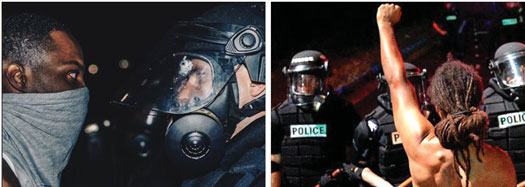
(R) Protests erupted after deadly police Shooting in Charlotte. (L) Demonstrators confront police officers.
|
Growing outrage, anger and a crisis in an explosive national climate
CHARLOTTE, N.C.—“Don’t get me wrong, not all police officers are bad. I’m not saying that but what it’s looking like from here, it’s getting worse. It’s almost like the new age Klan out here. I can’t let my babies come outside in this ‘good neighborhood’ because they Black and liable to get shot by police,” said Taheshia Williams.
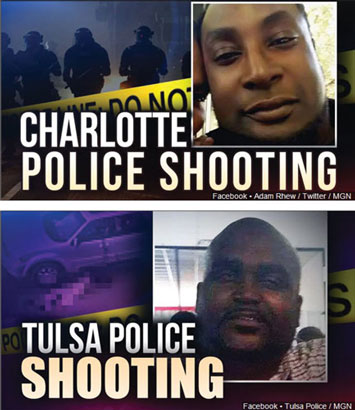
|
The wife and mother of three lives near the apartment complex where Keith Lamont Scott was shot to death by police officers. His death unleashed a wave of protests, unrest, disgust and once again focused the nation on Blacks gunned down by law enforcement officers.
The aftermath of the September shooting started with videos posted to social media, saying the 43-year-old father of seven was unarmed, reading a book and waiting for a son to get off of a school bus when confronted by cops.
Things quickly escalated to protests—then battles between police officers in riot gear and protestors. Next came more protests, more clashes and smashed windows in the city’s downtown area, a state of emergency, a curfew ordered by the governor and National Guardsmen and police out in force at a Carolina Panthers NFL football games as Sept. 25 protests against the shooting mounted. Police said Off. Brentley Vinson fired the fatal shots and that the victim somehow threatened officers and refused to obey commands. Off. Vinson is Black. The slain man’s family says he suffered from a traumatic brain injury and was harmless.
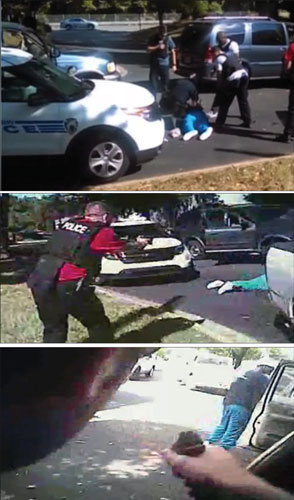
Charlotte Police release video evidence from the Keith Scott shooting. Photos: MGN Online
|
Jamar Williams and his cousin work in the complex as painters. He recalled seeing Mr. Scott during his routine morning walks. “Every morning I come in here and we see this man walk around the street and I’m telling you the man never bothered no one,” he said.
Allison Watson’s 10-year-old daughter Mya is friends with one of the Mr. Scott’s grandchildren. “I feel really bad for my friend’s family because it was her grandfather who got shot,” said Mya. Having lost her father last year, she feels for her friend. “I kinda know how much pain they are going through right now,” Mya said.
The Charlotte Mecklenburg Police officers involved in the confrontation with Mr. Scott, who was shot four times Sept. 20 at the College Downs apartments, located just south of the University of North Carolina Charlotte were captured on video. One video was done by the slain man’s daughter and another by his wife, who pleads with officers that her husband is not armed and not a threat. She pleads with her husband to exit the vehicle. He does and is shot to death by police, who insist a gun was found at the scene. The wife’s video shows no gun and skepticism grew as police had released a photo showing a purported weapon. Where did it come from?
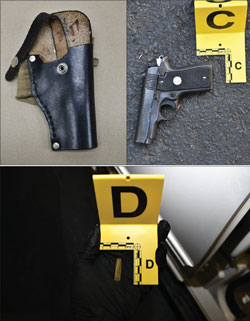
Police said a marijuana blunt was in Keith Lamont Scott’s possession as well as a gun and ankle holster. Photo: CMPD/Facebook
|
The chief of the Charlotte-Mecklenburg Police Department has said Mr. Scott was thought to have marijuana and a gun, which made the officers feel they had to confront him. Authorities said a gun with the deceased man’s DNA on it, an ankle holster and marijuana cigarette were found at the scene. Family members reject those claims by police. Authorities said officers observed Mr. Scott with the drugs, then a gun and donned vests identifying themselves as police officers before confronting him.
“Did he intend to point that gun? Did he really sit in a vehicle, waiting on his son to get home from school and then plot to shoot a cop if they pulled up on him? The reality is that they (residents) told me that Mr. Scott sits there in his vehicle every day wanting to pick up his son and hug him. And yesterday, his son could not get that hug,” said activist John Barnett, challenging the police version of events at a press conference. He and others demanded a complete, transparent investigation and justice for the Scott family.
“Every day across the country we are being shot down. Very few cops go to jail for that. Here in Charlotte just two years ago I was standing in court for Jonathon Ferrell,” said the activist. “Shot down 10 times. Shot at 12 times. Now how can the city of Charlotte cut a check for $2 million? If you cut a check for $2 million then obviously something is wrong. So how in the world would you not lock the officer up? And then give him his three year salary?” Mr. Ferrell was a Black man who was shot to death following a car accident.
Residents interrupted Mr. Barnett during the press conference, shouting Mr. Scott was by a “bald headed White officer wearing a red shirt,” not the Black cop.
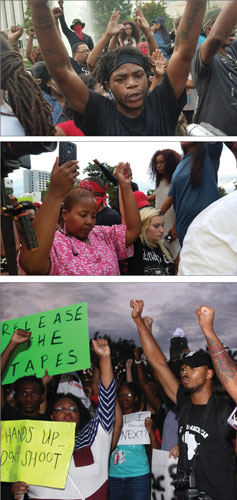
Protestors in Charlotte, N.C. Photos: Andrea Muhammad
|
Blacks cannot take any more of this, said Rashad Robinson, executive director of Color of Change.org, an online activist group.
“What you’re seeing is clear reaction and pushback from communities that have had enough, that cannot take any more,” he told The Final Call.
“The question is how much more can other communities who say they are of good faith, who say they want to be on the right side of history, how much more can they take?”
“Until there’s accountability, until police officers go to jail … until they are nervous about abusing and killing and mistreating Black people, this will continue to happen. But beyond that, we also want to make sure that we are clear, this is not about one or two ‘bad apples,’ ” said Mr. Robinson.
Color of Change is monitoring the Scott shooting and had launched an online petition which included a letter to Tulsa, Okla. District Attorney Steve Kunzweiler calling for an indictment of Officer Betty Shelby. The White female officer shot and killed unarmed motorist Terence Crutcher, 40, on Sept. 16, four days before the Scott shooting. Off. Shelby has been charged with first-degree manslaughter and is currently out on bond. She is due in court Sept. 30.
Off. Vinson, who officials say was involved in North Carolina shooting, is out on leave while an investigation continues. The Congressional Black Caucus has asked for the Justice Dept. to intervene in these shooting and calls have come for federal investigations.
“This is about a systemic problem in policing across the country. This is not just about White officers. This is about a system that incentivizes the mistreatment of Black people, that at times rewards it and always defends it,” said Mr. Robinson of Color of Change.
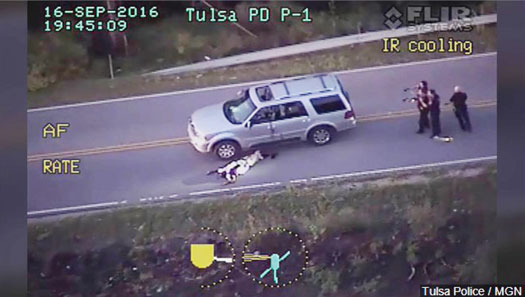
Tulsa Police helicopter view of the officer involved shooting of Terence Crutcher. Photo: MGN Online
|
Critics point to the apprehension of accused Charleston, S.C. church shooter Dylann Roof; accused New York, New Jersey bombing suspect Ahmad Rahami and accused Washington state shopping mall shooter Arcan Cetin as examples of police having the capacity to detain and arrest using non-lethal force. In the case of Mr. Rahami, he is reported to have been engaged in a gunfight with police but was arrested and taken into custody alive.
“Terence Crutcher was killed with no justification by a Tulsa, Oklahoma police officer. Keith Lamont Scott was shot in Charlotte, N.C., while the police were there to serve a warrant to someone else. We’re forced to ask the same question over and over: how many Black people have to die before we reassess policing in America?” asked the American Civil Liberties Union.
While he agrees police officers need to lose their jobs and being criminally charged is important, Mr. Robinson said the entire infrastructure of U.S. policing, including how departments are funded and run and how data is collected has to also be changed.
On Sept. 22 members of the Congressional Black Caucus marched in solidarity to the U.S. Justice Department and held a press conference in response to the continued killings of Black men, women and children at the hands of law enforcement.
The caucus wants Attorney General Loretta Lynch to aggressively investigate, indict and bring charges against police agencies and officers that kill unarmed Blacks, explained CBC Chairman G.K. Butterfield (D-N.C.).
“What more does America need to see that we have a problem?” asked Rep. Hakeem Jeffries (D-N.Y.).
Attorney Barbara Arnwine of the Transformative Justice Coalition said that in the two years since the killing of unarmed Black teen Michael Brown, Jr. in Ferguson, Mo., there have been some positive changes, including increased use of police dash and body cams.
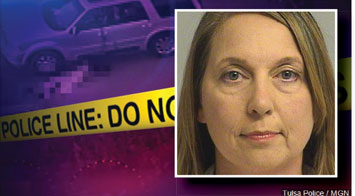
Mugshot of Tulsa Police Officer Betty Shelby
|
The fight for these cameras has meant there is a lot more video out there, she explained. “It is important that citizens are themselves more emboldened than ever to record events, record police interactions that they see,” the longtime attorney told The Final Call.
What’s happening is being seen as a national pattern now and not isolated incidents like in the past, she said.
“The fact that people connected Tulsa to Charlotte is critical,” she added.
The addition of body cams and dash cams has not deterred deadly encounters with police such as the cases of Mr. Crutcher and Mr. Scott. Where video footage exists, however, such as in the case of Eric Garner in New York or Tamir Rice in Cleveland, no charges were filed against officers in either death.
In the rare instances where charges are filed against officers, convictions are hard to come by. In Charlotte, dash cam and police video will soon be hard to come by. The police department released two videos of the Scott shooting and later said an officer failed to turn on his body cam until after the incident. But as of Oct. 1, a state law takes effect that says body cam video is not public record and does not have to be released. The legislation was passed over the summer and signed by Gov. Pat McCrory. Such video can be requested by a person or someone representing the person whose voice or image are in the video. Any other access to recordings from police body cams would have to be approved and be made in writing. The American Civil Liberties Union in North Carolina called the legislative act a “shameful law” that stunts efforts at transparency.
In cases where there has been federal intervention, whether substantive changes have occurred remains to be seen. The Civil Rights Division of the Department of Justice conducted two investigations of the Cleveland Police Department, the latest report coming in December 2014. It exposed continued problems such as excessive force and tactical errors by officers.
The Justice Dept. also investigated the Ferguson, Mo. police department. Its 2015 report found systematic racial bias and practices within the department that target Blacks.
St. Louis-area activist Anthony Shahid said little has changed since Ferguson and the death of Michael Brown, Jr. at the hands of then Off. Darren Wilson. Mr. Shahid fully supports the protests and uprisings particularly from young people.
“They’re shooting more Black people now than anywhere on the face of this planet earth,” said Mr. Shahid.
One of the lessons to be learned from Ferguson he told The Final Call “is that these White folks are going to come with money” as a divisive and diversion tactic to stop the momentum of protests.
Additionally, said Mr. Shahid, young people still see the “blue code of silence” in effect in police departments, meaning officers do not report the wrongdoing of one another. Yet law enforcement constantly condemns a “no snitch” position on the streets that inhibits their ability to apprehend those that commit crimes.
How much more can Black people take is the “billion dollar question,” Damon Jones, New York representative of Blacks in Law Enforcement of America, said.
“How much more can our Black elected officials allow our sons, daughters and children to be unjustly killed by law enforcement that is paid for by the taxpayers of each municipality? Why haven’t our Black elected officials really addressed the policies, procedures and training and really the culture of policing when it comes to Black males?” he continued.
The tendency for police to escalate from physical force to deadly force quickly, with no perceived threat, happens because of who we are as Black people, said Mr. Jones.
“That’s still at the core of policing, since it was created to enforce the slave codes and the Black Codes so until we have honest conversation on what policing is about and what policing is to Black communities since the creation of policing, we’ll never be able to change it,” he said.
We need some real substantive change or this is a powder keg that is going to continue to explode, commented Student Minister Robert Muhammad on his “Connecting the Dots” radio program that aired on KPFT 90.1 FM Sept. 21.
“The fuse has been lit. Not that it’s going to be lit, the fuse has been lit and until we have a sitting across the table one with another and get this thing straight, it’s going to be a spark,” said Dr. Muhammad, who also serves as Southwest Regional Representative of the Nation of Islam and the Honorable Minister Louis Farrakhan.
In leading up to last year’s 20th anniversary of the Million Man March themed “Justice Or Else!”, Min. Farrakhan warned audiences in cities across the U.S. that the unjust killings of Blacks would not stop and would increase.
As the 21st anniversary approaches this Oct. 16, the Muslim leader continues to warn America, explaining that the grief of Whites and Blacks is not the same.
“You’re trying to ingratiate yourself to our 460-year old enemy? What are you expecting from them?” the Minister said during a recent address in Washington, D.C. at Union Temple Baptist Church. He used the example of the Dallas police shooting where a Black gunman was accused of killing five police officers. He was subsequently killed when police detonated a bomb dispatched by a robot.
“They could hardly find what was left of that brother. So the families could grieve, but they got the man that killed their loved ones. Our grief continues, because when they kill us, and there is no justice coming to us, our grief keeps going on because we have not received justice,” said Min. Farrakhan.
INSIDE STORIES AND REVIEWS
-
-
About Harriett ... and the Negro Hollywood Road Show
By Rabiah Muhammad, Guest Columnist » Full Story -
Skepticism greets Jay-Z, NFL talk of inspiring change
By Bryan 18X Crawford and Richard B. Muhammad The Final Call Newspaper @TheFinalCall » Full Story -
The painful problem of Black girls and suicide
By Charlene Muhammad -National Correspondent- » Full Story -
Exploitation of Innocence - Report: Perceptions, policies hurting Black girls
By Charlene Muhammad -National Correspondent- » Full Story -
Big Ballin: Big ideas fuel a father’s Big Baller Brand and brash business sense
By Bryan Crawford -Contributing Writer- » Full Story






 Click Here Stay Connected!
Click Here Stay Connected!








